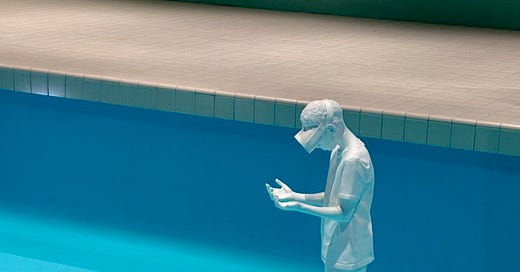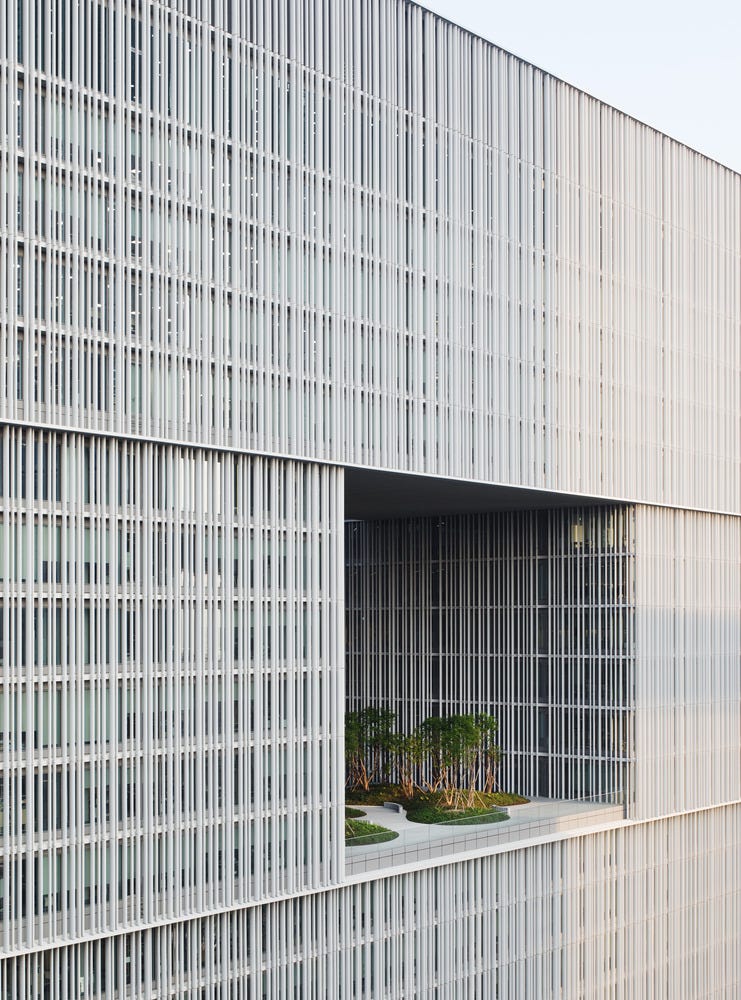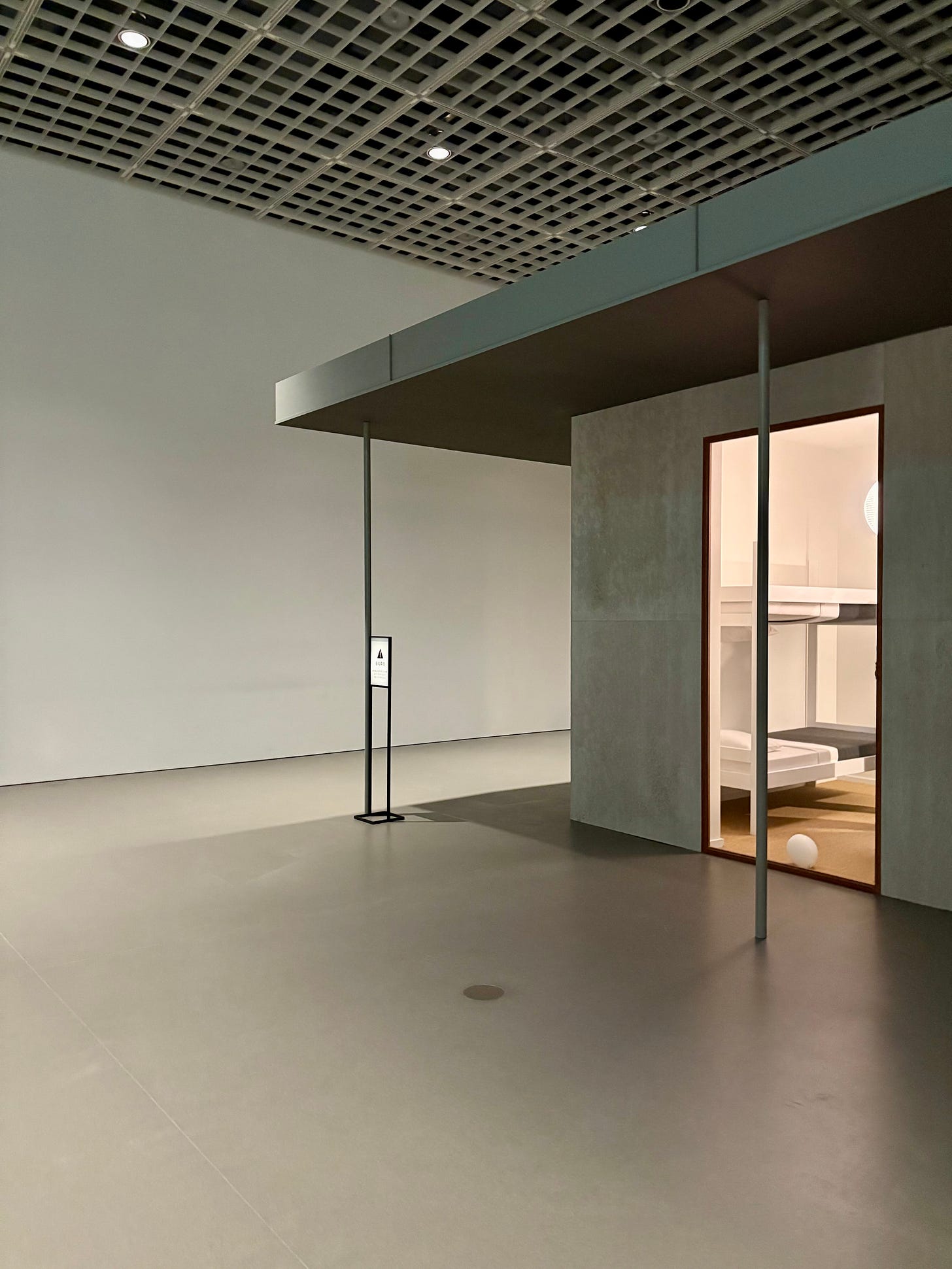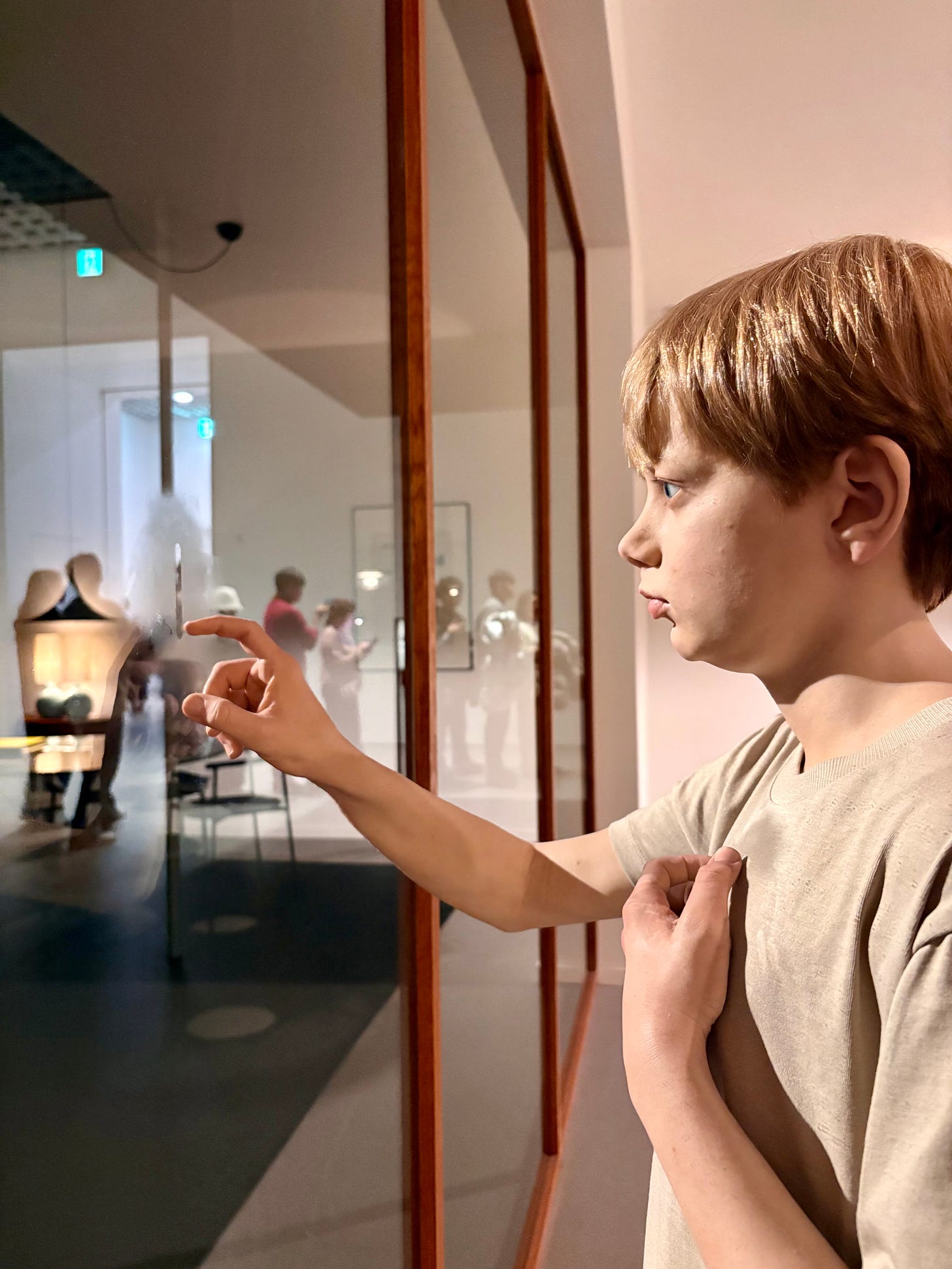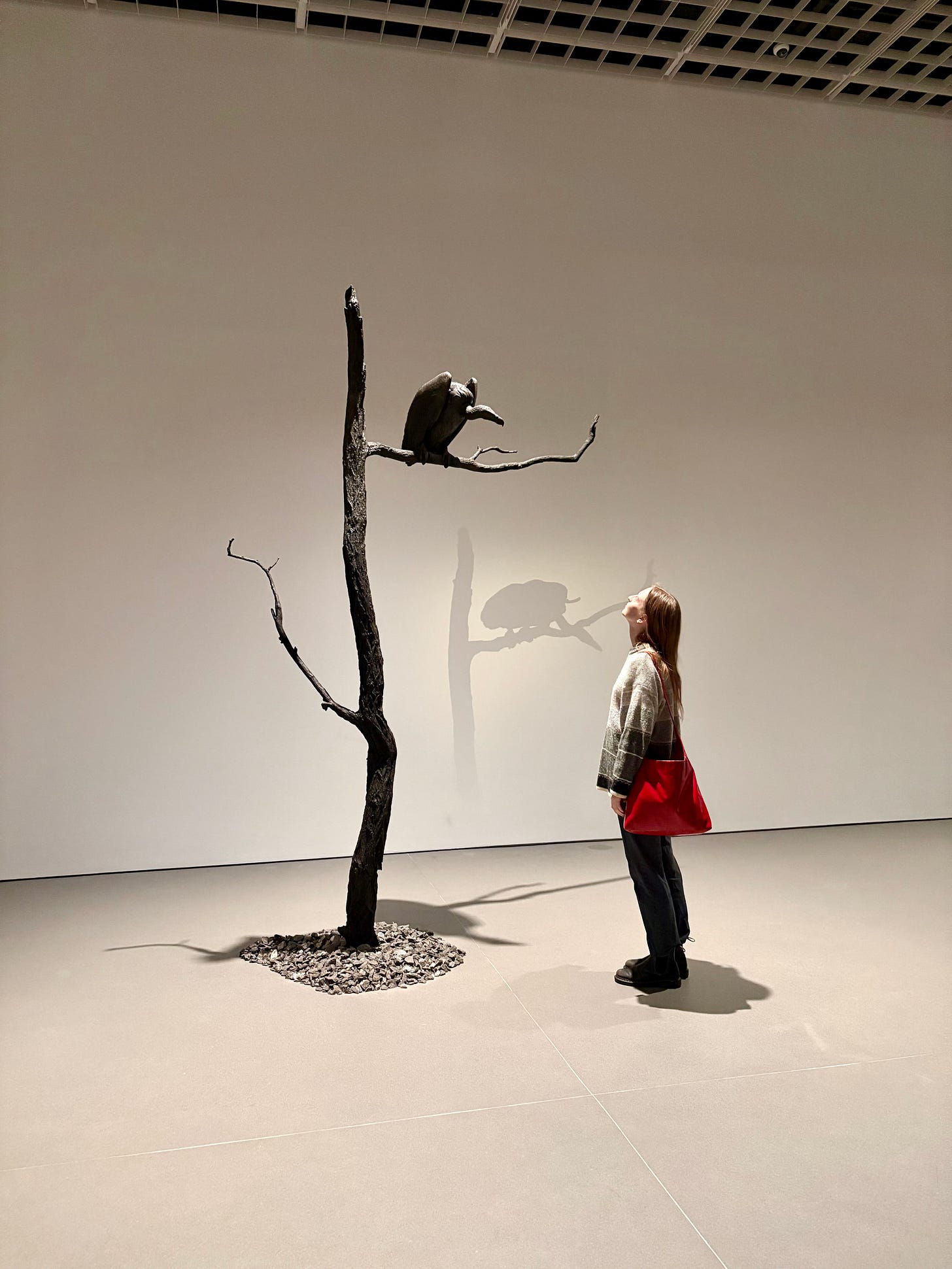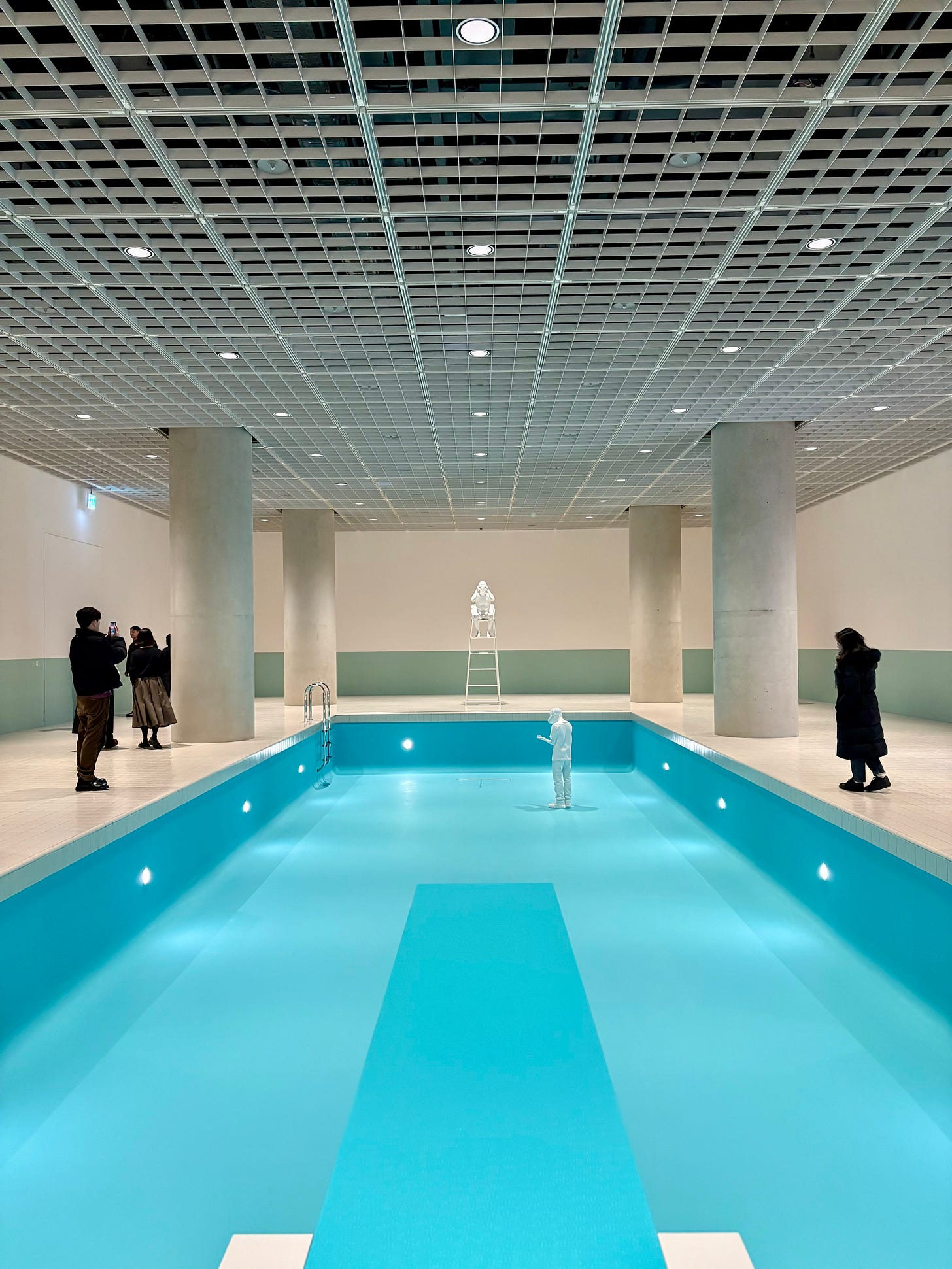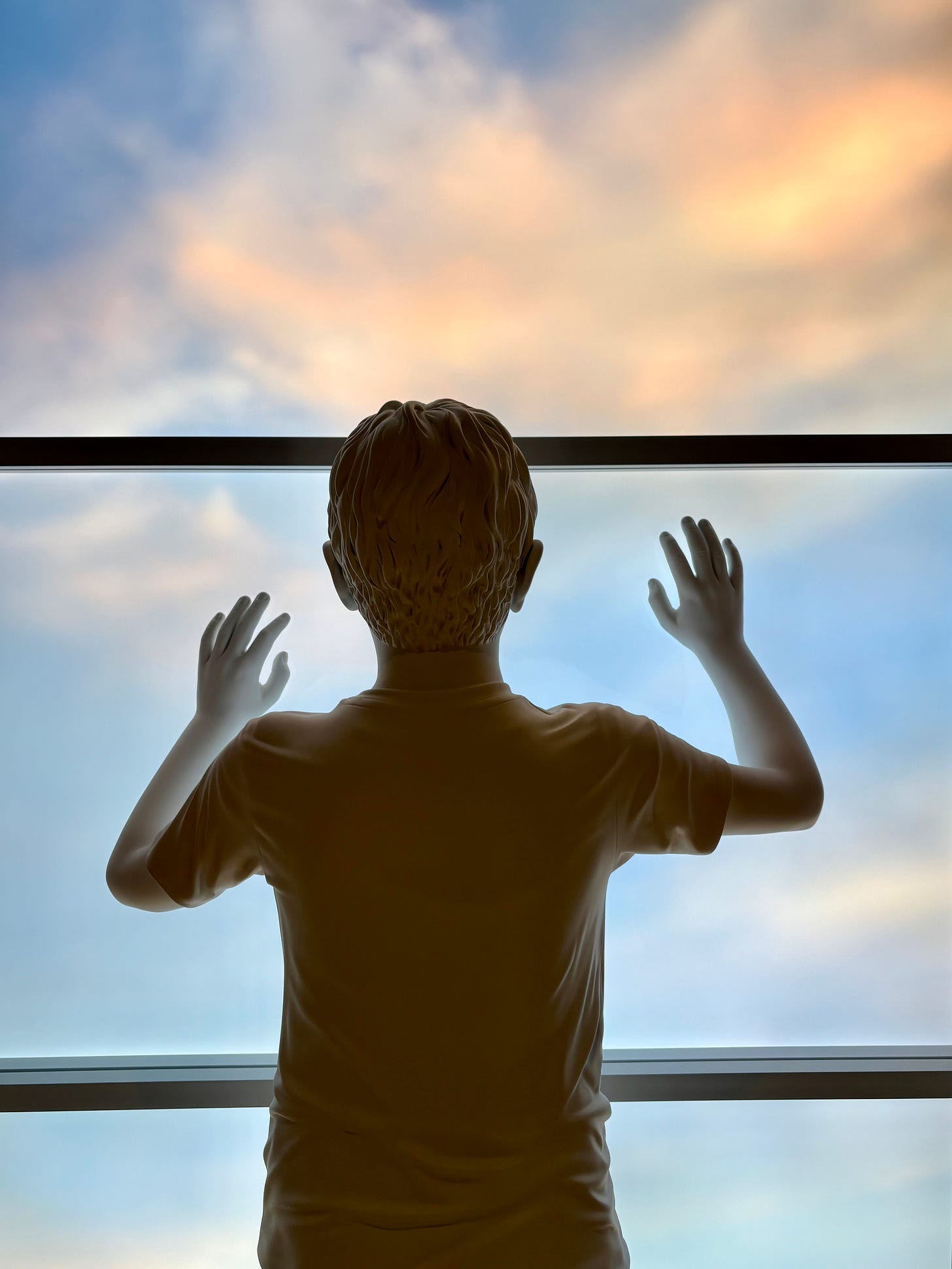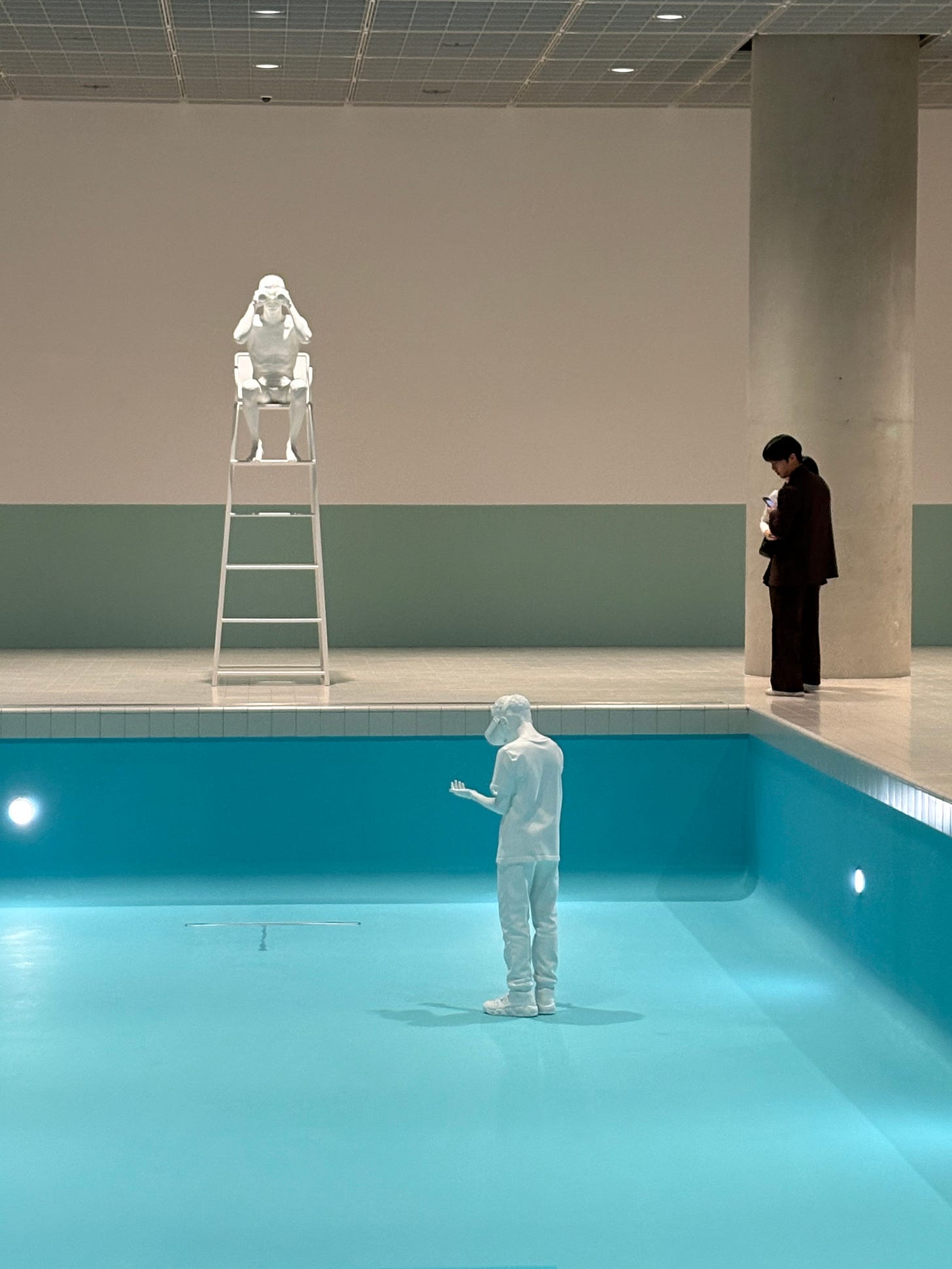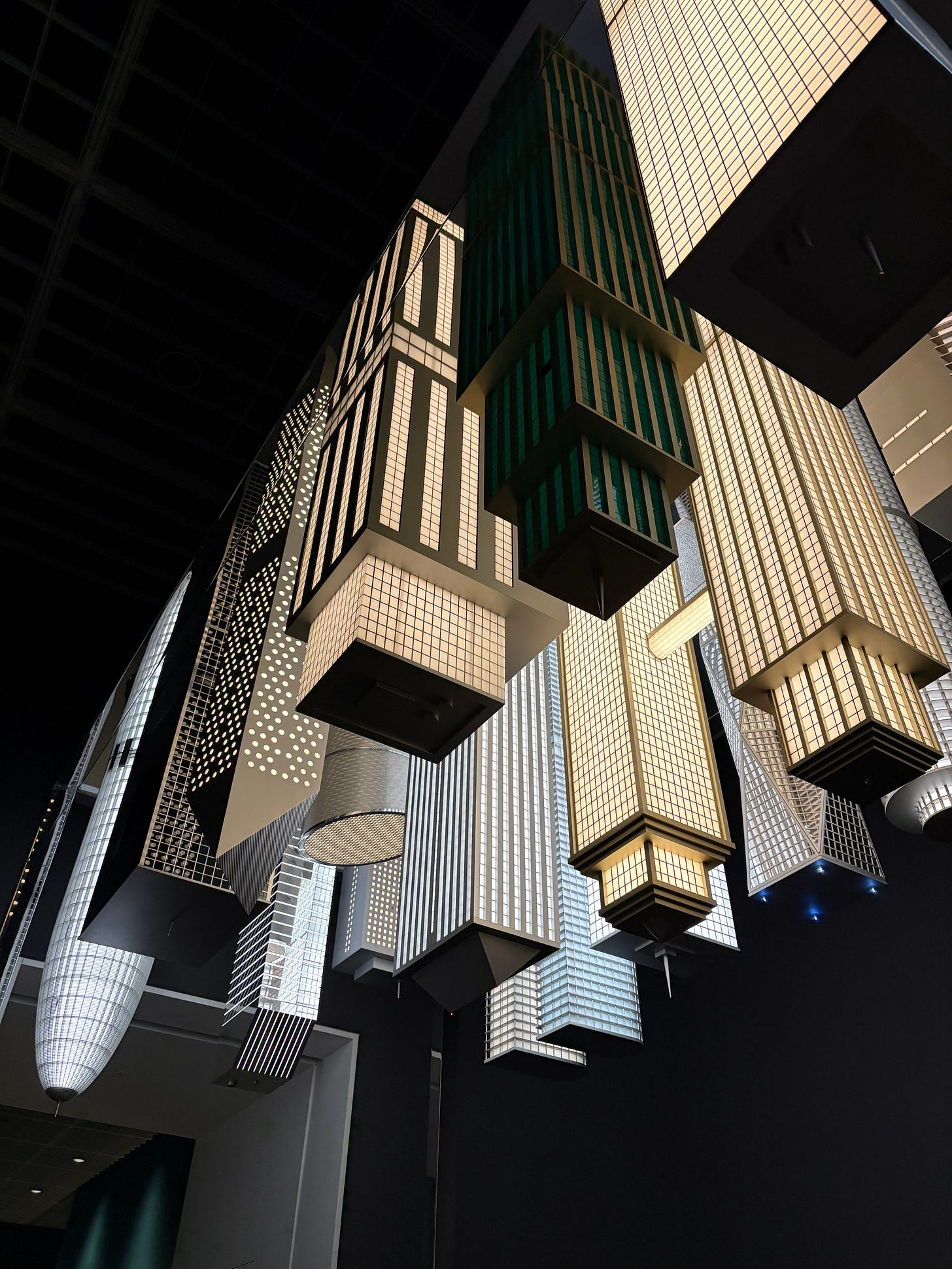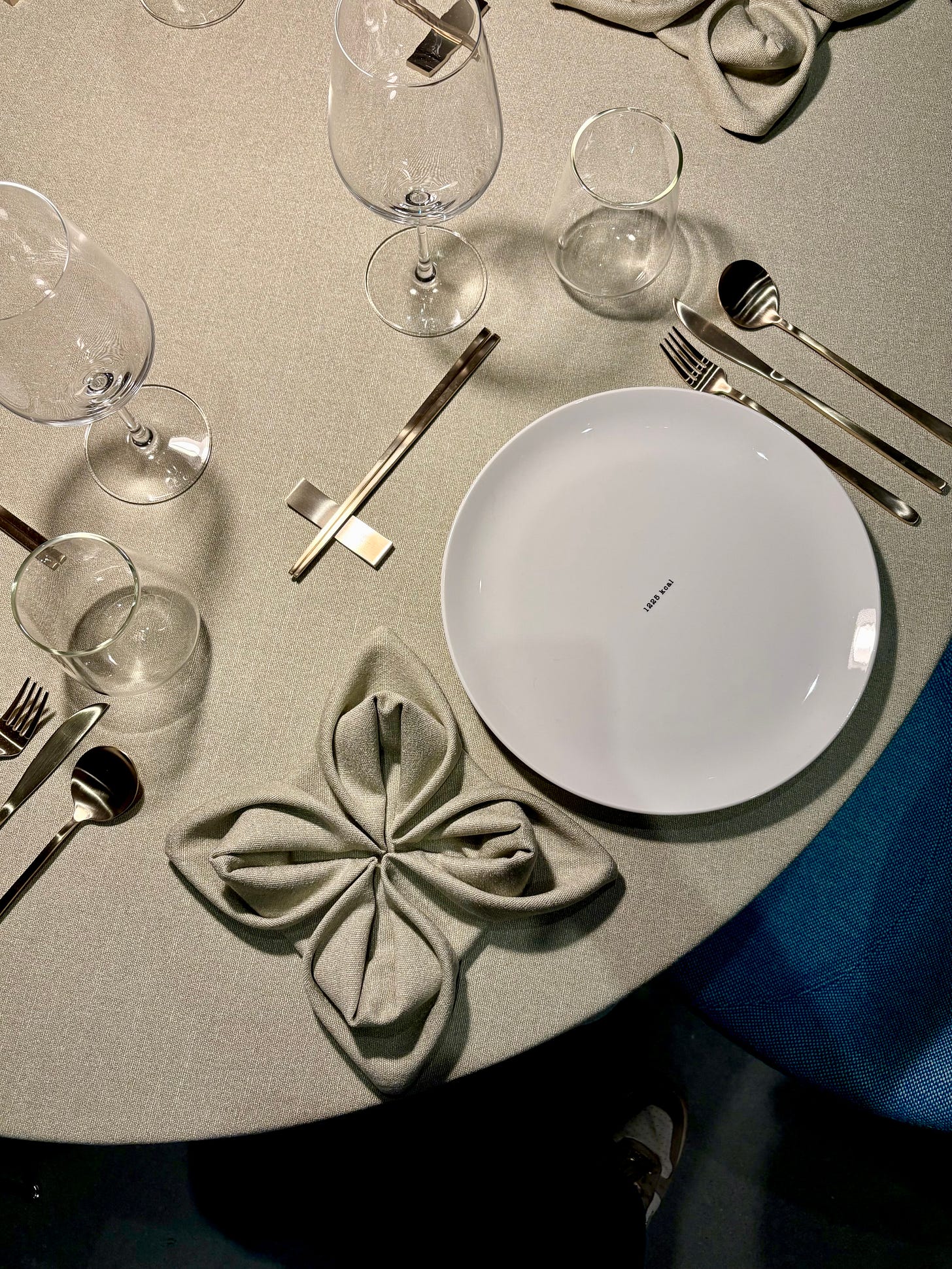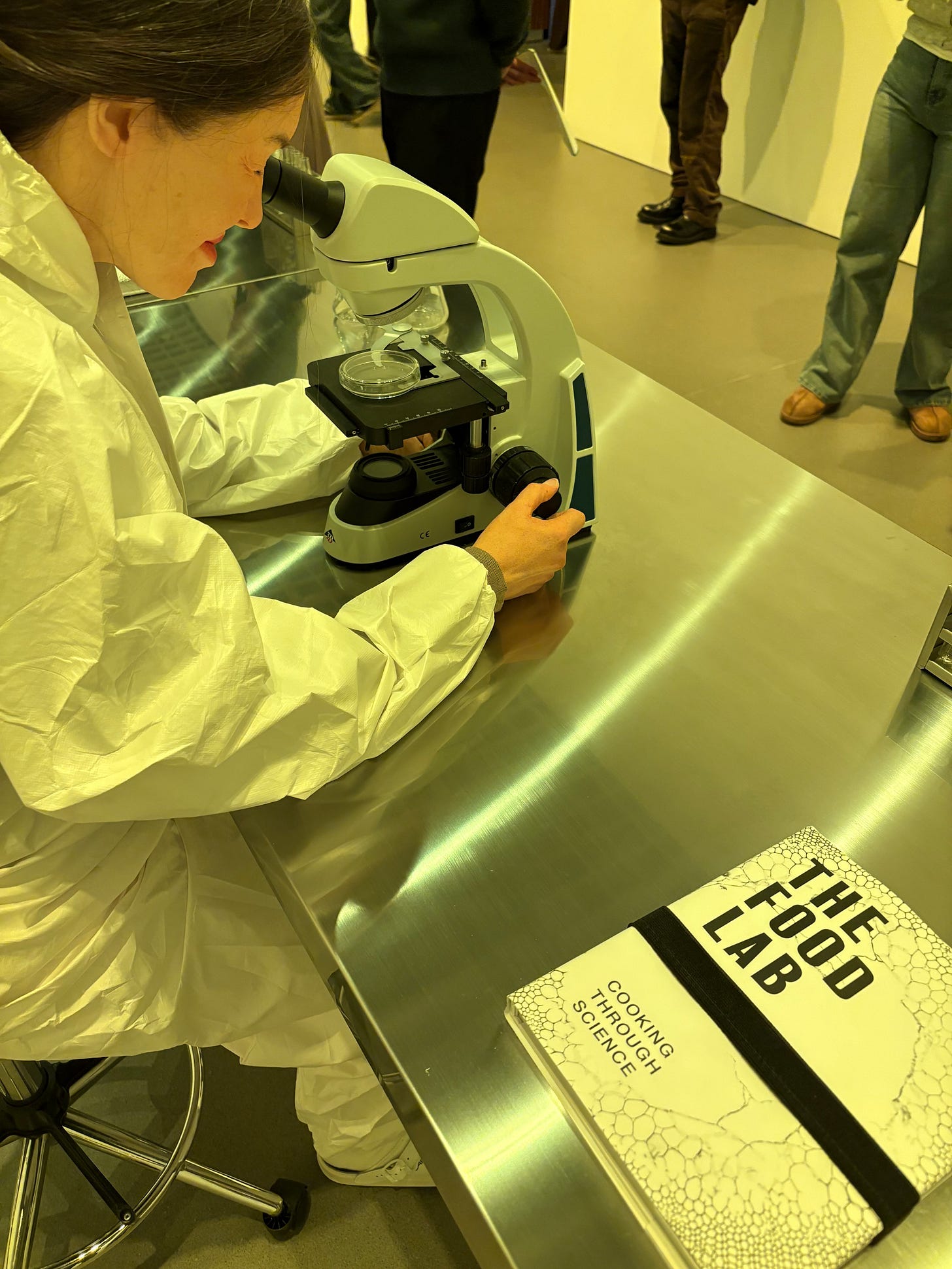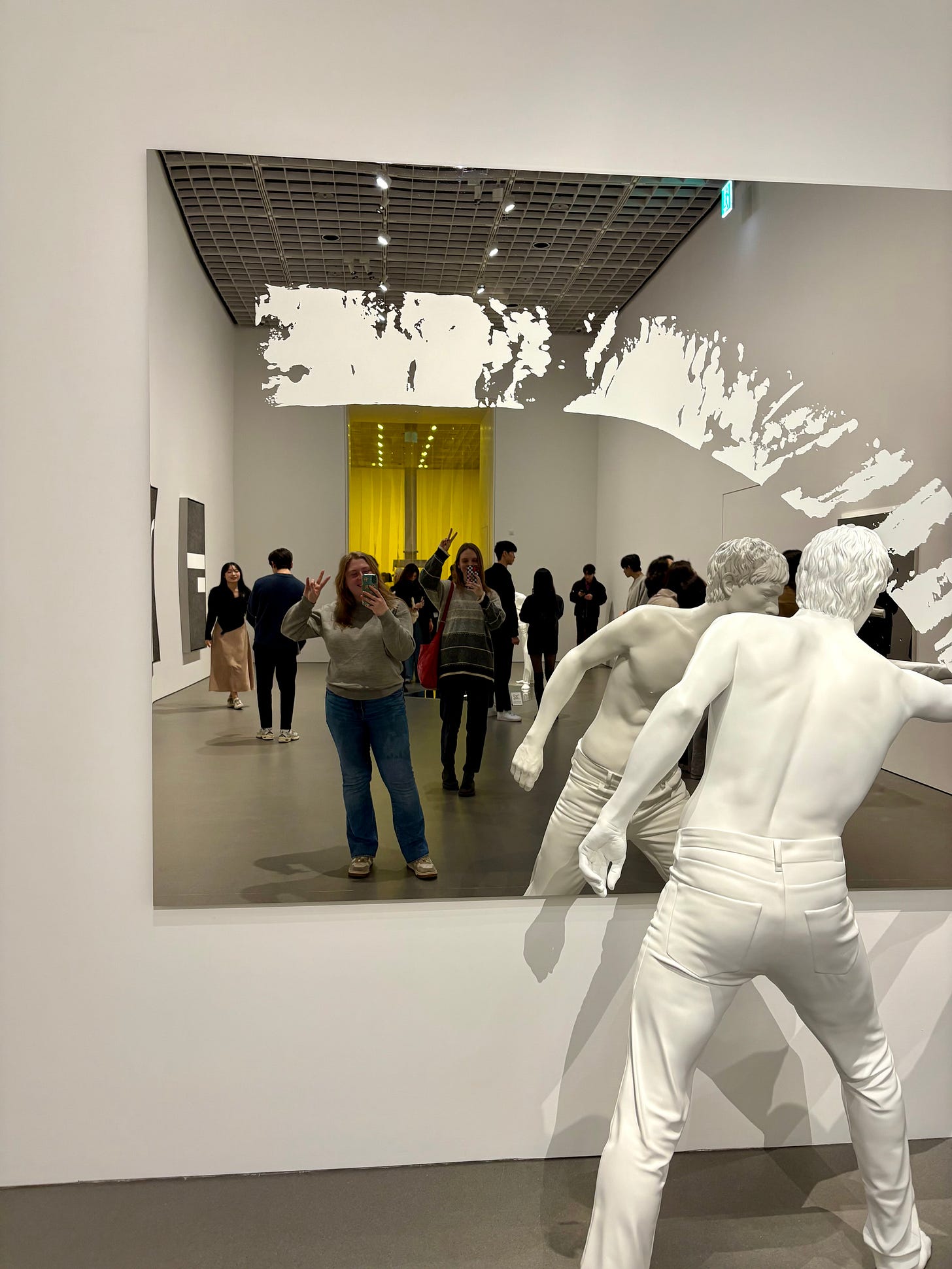I almost didn’t go to see this show for 2 reasons:
Timing & forgetting the closing date (oops)
Admission to the Amorepacific museum is ~*pricey*~ in this economy
But thankfully, two things happened:
artdrunk posted a reel that reminded me that this show had not, in fact, closed yet
I came into some cash
And then an even better third thing happened, which is that Kate was free to go with me.
So that’s how I found myself waiting for her in the lobby of the Amorepacific headquarters. The beauty and skincare-obsessed like myself might recognize the name, but for those of you who might be unaware, Amorepacific is Korea’s largest and most successful beauty-focused conglomerate. They own and operate over 30 brands including Sulwhasoo, Laneige, and Innisfree. They even own and operate Osulloc, a luxury tea company based out of Jeju Island.
The building is a masterpiece designed by David Chipperfield Architects, the same team who designed the revamping of the RA Schools when I was working there during graduate school in 2017/18. Their designs always strike me as immensely thoughtful no matter the scale, this building being no exception. Even as I find myself a lukewarm fan of brutalism at best, his reinvention of it in the interior of this space—accented with greenery and flooded with light from above—has me rethinking things.
The Amorepacific Museum of Art’s gallery spaces are all housed in the basement levels of this building, which is cool but also a bit…odd. When I mentioned to a friend that I’d be going to the museum, she looked at me very clearly confused and said, “Wait, they have a museum? Where?” But even despite where it is tucked away, it had no problem attracting visitors by the dozens on this particular Saturday.
Now to be honest, prior to this exhibition I had a pretty surface-level understanding of Elmgreen & Dragset, albeit most of which had left an overall positive image of their practice. Prior to seeing this exhibition, I think that in my head they fell into a similar category to artists such as Charles Ray, Jeff Koons, and others whose sculptural works upon first glance lack that initial, often difficult-to-penetrate layer of, “this artwork is more than what you see.” But, then again, that’s not necessarily a bad thing.
Essentially, what I mean is that artworks that are more immediately accessible conceptually—artworks that physically show up as what they are, that don’t hide their motivation to make you think—can at times be taken as, well…only shock value. Which they contain, sure. But depending on the artist, this can be well-received or just as easily used as an excuse to write off seriousness of intent.
Ok, I don’t think I’m making sense… Let me break it down quickly:
I could talk about “accessibility of meaning” in artworks for hours and thousands and thousands of words, but I’ll spare you that torture for now. In my opinion, this comes down to an odd sub-perception within certain circles that the degrees of accessibility of conceptual meaning can either add to or take away from the prowess of an artist. To be blunt, this of course depends on who they are (and how much their work sells for), where they graduated from art school, etc. It’s the difficult-to-define reasoning behind why the ability to immediately connect to the symbolism in Andy Warhol’s “Campbell’s Soup Cans,” is seen as profound and historically significant, but artwork sold in small galleries with similar symbolism probably won’t end up in MoMA.
There’s just no real rhyme or reason other than privilege and timing.
All of this being said, the accessibility and “instagram-ability” of Elmgreen & Dragset’s works shouldn’t be taken lightly. The ability to interact with these works as one could in this exhibit allows viewers at all degrees of engagement with fine art to walk away thinking about layers upon layers of commentary and meaning that they maybe didn’t expect to find. Even if one was only showing up for the aesthetics, they probably left the show with more questions than answers.
Ok, now let’s get away from my ramblings and to what you’re here for: the exhibition.
SPACES is the largest showing of Scandinavian duo Elmgreen & Dragset’s work in Asia in the 30 years they’ve been making art together. E&G have been pushing the boundaries of sculpture and discourse for decades, actively pursuing questions of identity and belonging in order to investigate social, cultural, and political structures. Their work often radically recontextualizes objects, altering normal modes of representation for art.
In 2009, they were selected as representative artists for the Danish and Nordic Pavilions at the 53rd Venice Biennale, and their works have been displayed all over the world. They are currently represented by prominent contemporary galleries such as Pace Gallery, Kukje Gallery, Massimo de Carlo, Perrotin, and Victoria Miro Gallery.
When you first enter the exhibition, you can head to the right and, depending on the time, can view two video works: How are you? and Drama Queens. One film follows the preparations made for their pavilion at the Venice Biennale, while the other seems to be a conversation made between different sculptures, each evoking their own personality (stereotypical or not).
If you’ve been studying art for a while, I’ll admit that both will make you giggle. Watching them prepare for the biennale will give your panicked-gallery-assistant-heart some palpitations, while the imagined conversation will vindicate your annoyance with Jeff Koons yet again.
Once your time there is up you can head into the main installations, starting with a single level, built-to-scale house that the viewer is permitted to walk through. Each room takes on a whimsical, odd aesthetic layout: pipes from the two sinks in the bathroom are connected to each other rather than to the ground beneath, bunk beds that mirror one another, a child’s room with no color but white, vases that are upside down. In the living room, a child seems like he’s questioning how real this home may or may not be.
There are some Easter eggs along the way as well if you can pick them out:
a small statue of the duo’s past Fourth Plinth commission
a bookshelf with titles such as “The House of Spirits” by Isabel Allende, catalogues of the Seoul Media City Biennale of Architecture and Urbanism, “Confabulations” by John Berger, and an expected biography of Foucault
A mirror with writing that says, <다시는 보지 말자!>, “Let’s not see each other again!”
A vulture sits on a tree branch just outside the home and is the only other sculpture in this section of the exhibition. Is it a commentary on the home or on us? Probably. But mostly it made for a great photo moment for Kate.
The following section is even more structurally impressive, which is hard to believe after the duo designed a literal house. But E&G would never play their hand to its totality from the get-go, would they?
They built a to-scale swimming pool! Which is honestly kind of insane?? Isn’t that insane? Is it just me?
For most of us, a very general image exists in our heads of what displaying fine art is supposed to entail: abstract paintings on white walls with nice lighting, funky sculptural forms on plinths (?), or maybe a strange video work being projected in a dark room. So when that image is broken to bits by a swimming pool, it’s exciting to watch people around you make sense of a new understanding taking root in their minds. As much as I took in the scale of this artwork that, much like the house, we were able to experience with multiple senses, I also took in the observers around me.
To my right, two friends were taking photos of each other and giggling, pointing out the most photogenic sections of the room. In a far corner, an older couple were in awe of one of the hyper realistic sculptures sitting on the edge of the pool, softly theorizing about how long it must have taken to make them. On the left, a group of men playfully pushed each other while they scrambled to look through a peephole in a closed door, which upon closer inspection showed us the moon. Behind me, a father whispered quietly to his daughter who he carried around the room, whose eyes were huge with confusion and curiosity.
I’m reminded in rooms like this that I know a lot about art, but sometimes I wish I knew less.
Something that Kate and I observed as we were leaving the room was how it seemed that every sculpture was looking elsewhere, multiple points of view overlapping but never fully interacting:
The lifeguard looks through binoculars directly at the viewer as they enter the room.
The boy above stands in the empty pool wearing a VR headset, possibly feeling and experiencing the water that no longer fills the space.
A boy farther down sits on the edge of the pool in swim shorts, looking down at where his reflection should be but is no longer.
A boy stands in front of a window near the pool, a sky illuminated that cannot be touched.
Moving along, you enter a small space with a skyline sculpted upside down on the ceiling above. This makes for a lighter transition into the larger space beyond. I appreciated this quite simply because it looked cool. Skyscrapers on the ceiling!
Now, I’m going to try to combine the next two areas into one because they’re linked (and also because this is already longer than I intended.)
The next two areas are linked in that one is a restaurant/dining area and the other is the attached kitchen.
The dining area is first and it leaves the viewer with a pretty ominous feeling as they enter. And yet even with that feeling, it’s not like that’s an aspect that’s subtle or hidden. It’s like you enter the room and this feeling is the baseline; now all you have to do is find the specific reasons as to why everything feels so off.
For me, this room represents a distortion of reality. A natural escalation from the distortions we’d seen around the pool and within the house, this feels like a direct confrontation. Plates lack food but display calorie counts; the only guest present is on her phone watching TikTok; the artworks on the wall of the dining room physically and visually distort the viewer when looked at. All of these elements come together and make us wonder: what exactly is in front of us? When out in the world, what am I really seeing in front of me?
Afterwards, we enter the kitchen. Or…is it a laboratory…?
Or maybe it’s called, “The Food Lab”…?
Whatever you think it is, for me it represents yet another distortion. This time, the distortion was how we think of our food, the same food that will eventually end up on the same plates with calorie counts just next door. We over analyze and scrutinize every choice that we can possibly make around food: its origins, how it may or may not be processed, whether or not it's been processed, etc. Is eating even one more gram of rice going to destroy the workout I just did? ……
There’s also a few odd objects placed around the kitchen; again, something is always a bit off and subsequently throws the viewer off. I can’t sit here and tell you that I understand the meaning behind each and every oddity (and that would take forever) but I can definitely show you a few highlights that made me pause.
And with that…fin!
See y’all next time!

